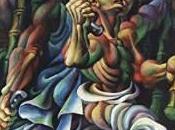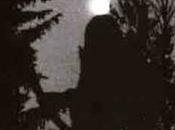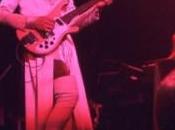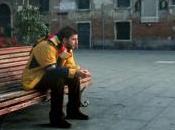- Da Komikazen 2011: il fumetto politico di Seth Tobocman
- Komikazen 2011: Seth Tobocman and political comics. ENGLISH VERSION
- KOMIKAZEN 2011 – Amir and Khalil, an interview ENGLISH VERSION
- KOMIKAZEN 2011 – I figli perduti dell’Iran: intervista a Amir e Khalil
 > LoSpazioBianco" />> LoSpazioBianco" />> LoSpazioBianco" />> LoSpazioBianco" height="176" width="634" alt="Komikazen 2011: Seth Tobocman and political comics. ENGLISH VERSION >> LoSpazioBianco" class="aligncenter size-full wp-image-40348" />
> LoSpazioBianco" />> LoSpazioBianco" />> LoSpazioBianco" />> LoSpazioBianco" height="176" width="634" alt="Komikazen 2011: Seth Tobocman and political comics. ENGLISH VERSION >> LoSpazioBianco" class="aligncenter size-full wp-image-40348" />
I’ll start with a basic question. When and how do you begin to do comics?
I started drawing when I was very small. I was actually told by a pre-k teacher that my drawings were awful which only made me think that drawing was something very important and I should learn to do it. We spent a year overseas when I was in kindergarten, so I could not understand anything people said and spent all my time drawing. When I got back to the U.S. drawing was what I was good at. Then a few years later I discovered Marvel Comics and saw that the artists were credited on the first page. And I thought “Wow, someone has a job drawing comics. That’s for me!”.
I read on your site that your uncle knowing that you’re going to be a comic artist told you “If you want to be an artist, then you can never sell out, or you won’t be an artist any more.” Do you describe yourself as an artist? Do you ever try to follow his suggestion?
What my Uncle was talking about was the pressure in the family to go into some field where you make good money like law or medicine. A pressure he had succumbed to and which I have resisted.
The word artist has all kinds of cultural connotations. What he meant by artist, and what I mean by it, is someone whose profession is to draw pictures. And yes, I try to be that.
As a boy you started as a superheroes fan, then you became an esponent of alternative comics scene. From mainstream to self-published comics. How did this happen? What influenced you to pass from a world to the other?
As a kid, the superheroes were like real people to me. I followed the stories and was sad if someone died. Then at a certain point I noticed that the same plot lines repeated themselves over and over again. It was all formula. So I lost interest in that. At that time there was not much of an alternative comics scene at all. So I got into other areas, film, rock music, painting. But by the time I was 20 it became clear to me that comics were where I belonged. So I tried to invent a new kind of comics that would be as real to me as an adult as the superheroes were for me as a kid.
You knew and worked with the most important underground artists. I mention only the most known in Italy as Harvey Pekar and Robert Crumb, but also Peter Kuper, Ben Katchor and Eric Drooker. Could you tell me something about your relationship with them. What did they teach you?
It’s hard for people today to understand how small the comics scene was in the 1970s. As a couple of teenagers publishing a comics fanzine, Peter Kuper and I knew everyone who was into comics in the city of Cleveland. The comic book club we were in included black kids from Shaker Hieghts and poor white kids whose fathers worked in the steel mills. But we never noticed this because all we talked about was comics.
We also got to know a grumpy comic and record collector named Harvey Pekar. Harvey scared me because he always seemed depressed and even suicidal and was always taking pills. But then Harvey started making these realistic comics about his own life. No one was doing that at the time. I think it was a real breakthrough. I think this idea has changed, not only my comics, but everyones.
Peter Kuper and I have worked together all our lives. We have different temperaments, but we kind of understand each other. His control of materials is impressive. He is incredibly hard working and professional and has been a role model to me and many other people in this regard . He always produces a beautiful finished product, even in his sketchbooks. Diary of Oaxaca, which collects his sketchbooks of the protests in Oaxaca, is an amazing book. I also think his adaptation of the classic socialist novel “The Jungle” is probably the most sophisticated use of stencils I’ve seen in a comic strip.
Eric Drooker I met when I was in my 20s, living in the Lower East Side of Manhattan and very involved in housing politics. We went to meetings and demonstrations together. We had a graffiti team that consisted of me, Eric, Paula Hewitt, Chuck Sperry and Josh Whalen. We would put out posters and stencils against police brutality and gentrification and in support of the squatters movement. From Eric and Paula I learned to connect the big international issues like war and imperialism to local issues like housing, drugs and the economy. I think his book Flood is one of the most important comics of my generation.
In general, as editor of World War 3 illustrated, I am constantly meeting new cartoonists, and also activists who want to get their ideas out, and I learn a lot from them. In a way, the movement has been my university.
Your stile was also influenced by graffiti artists. How did they influenced your work? Why didn’t you become a graffiti artist?
We did a lot of street art in the 1980s but a lot less after mayor Giuliani started to crack down on street art.
Putting my work out on the street taught me to make things really clear and simple, because it has to be understood by people walking by, and also because it is gonna get damaged out there. So, will it still be readable with mud splashed all over it? I liked the idea of the faceless figure put forward by Keith Haring, Richard Hambleton and also by the Sandinistas.
From a technical point of view, could you tell me something about how do you draw? Which instruments do you use? How your approach to drawning evolve with time?
I generally start with a quick thumbnail sketch then blow it up to a larger drawing. I start in pencil or graphite and finish in another medium.
Nowadays I try to be more realistic. So I may also do quick sketches of a real situation or model as reference. Usually do sketches with woodless pencil in my sketchbook.
Your comics are always be connected with political engagement. Do you think that comics is a way to reach more people or is only your way?
I think it is natural for people to make art about things that matter to them. I care about politics so I make political art. History will judge whether this was the best way to get the message out.
The Eighties in the United States are a prolific period for comics (political) magazine. Could you tell me something about the born of Warld War III? Do you think that your and Peter Kuper magazine influenced your readers understanding of social and political problems of the period?
Back in 1980 there were maybe 4 comic books in the U.S. that were aimed at an adult audience. Harvey Pekar’s American Splendor, Spegelman’s Raw, Ben Katchor’s Picture Story Magazine and our World War 3 Illustrated. We started this magazine because without it there would have been no place to publish political comics.
There were a number of events that made us want to do a political magazine, the “White Nights” riots in the wake of the assassination of gay politician Harvey Milk, the melt down at the 3-Mile-Island nuclear plant, and the placement of U.S. nuclear weapons in Europe. But most significant was the Iran Hostage Crisis. Or, more to the point, the American reaction to that crisis. I mean, I go into the supermarket where I’ve gone all my life, and they are selling these big buttons that say “FUCK IRAN”. And they are selling them to the same people who would have slapped me for saying the word “fuck” as a kid. So we felt, if those people can express themselves, so can we. Let’s do a political comic book.
Starting out, our politics were pretty much liberal, “we don’t like Reagan”, sort of politics. But putting out this magazine was like raising a banner. All kinds of people were drawn to that banner and they educated us and the magazine became the voice of a small but very active anarchist community in the U.S. I would say our readers influenced us as much as we influenced them.
How do you work on the stories you draw? Do you interview people? Or do you only watch the world around you?
Generally there is some little thing that sets me off. Like when I was in New Orleans people pointed out that the helicopters flying over head were tours for real-estate developers, and I immediately thought of vultures and I had the hook to string together my impressions of post-Katrina reconstruction. I then had to flesh the idea out by researching the situation. I did sketches and took photos. Then back in New York I also had to study vultures at the Bronx zoo.
For some pieces I also need to do interviews or other research. It all depends on the subject. I like to know what I am talking about before I do a piece.
You have always been engaged in political movement: from squatters to your recent journey to Palestine.Your last work is on cause and effect of economical crisis in the United States. What do you think of contemporary movements as Occupy Wall Street or We are the 99%? Do you think that these movements can have influence on the present situation?
For the last 30 years capitalism has been treating the American economy the way a junkie treats his veins. Trying to squeeze out every last buck with no concern about the future. The current economic collapse is the result of that.
I started doing work on UNDERSTANDING THE CRASH because of visiting my hometown of Cleveland in 2008 and seeing all of the boarded up houses there.
Occupy Wall Street is just the latest expression of a movement against the Big Banks which really started back in 2007 with local groups protesting the foreclosure of houses. Then joined by municipal unions protesting lay-offs of city workers. But O.W.S. changes that movement. It brings in youth, counterculture, the homeless, and a range of adventurous tactics that a working class community organization or a large labor union would shy away from. I think this is a good and necessary escalation. So far the American public has embraced O.W.S. in a way I have never seen the left supported. So I think the idea of 99%, of uniting the poor, the working class, the middleclass, students and counterculture against the %1 who control the system, seems to be working. And this makes me hopeful.
Who are your readers? Who are your works addressed to? Do you ever ask yourself if you could be read by someone who doesn’t share your political view?
Well, you don’t choose your readers. They choose you. I find my readers are very intelligent and active people. When I meet a fan of my work, I often find that they are doing something interesting themselves, like publishing a zine, making films or organizing in their community. I’m very happy to have the support of such people.
You also taught comics. Is it really possible to teach comics as an art form?
It is weird to teach school when I never finished school because my art teachers all seemed to hate comics. But the fact is that the School of Visual Arts has been teaching comics since the 1950s. Steve Ditko, the inventor of Spiderman, studied comics at SVA. Teaching gives me a way to interact with younger cartoonists outside of meeting them at demonstrations.
In Italy is very difficult to read your works (there is only one translated book of yours by Hazard). I searched on internet some ebooks and I find only one, either against payment or rights free. What do you think of digital comics? And do you have a position on web copyright law?
I think the guys at Hazard took a big risk by publishing my book, DISASTER AND RESISTANCE and they ought to be supported by people buying it. If they sell enough of this one perhaps they will put the others out in Italian as well.
And now the most difficult question. I think that comics is both a direct and a very complex media. Do you think this media and artistic form have a future?
The comic book industry, like the music industry, like the publishing industry, is having trouble making money because of the internet. But there is a difference between comics, and the industry. Comics are very popular right now.
For several generations, comics were in an odd position. There was this industry that paid artists well, but stole their intellectual property and restricted them to doing stuff for kids. Artists complained that they wanted comics to be treated as an “art Form”. Well, be careful what you wish for. It’s happening. Comics will become more of an art form, less of a business. That means a few artists will make a living at it but many more will be struggling.
When I teach comics classes, I find that half my students are female. This would have been unheard of 20 years ago. This is the first generation of comic artists who don’t experience comics as having some kind of stigma. They can work on any subject they want, and if they do serious work, the world will take them seriously.
This art form has emerged. But being an artist has never been easy.







